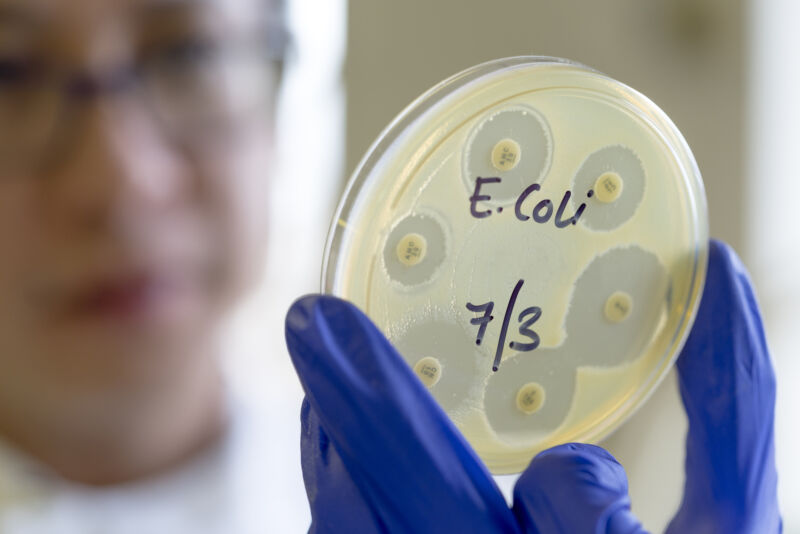Genetic mutations are essential for innovation and evolution, yet too many—or the wrong ones—can be fatal. So researchers at Cambridge established a synthetic “orthogonal” DNA replication system in E. coli that they can use as a risk-free way to generate and study such mutations. It is orthogonal because it is completely separate from the system that E. coli uses to copy its actual genome, which contains the genes E. coli needs to survive.
The genes in the orthogonal system are copied with an extraordinarily error-prone DNA replication enzyme, which spurs rapid evolution by generating many random mutations. This goes on while E. coli’s genes are replicated by its normal high-fidelity DNA copying enzyme. The two enzymes work alongside each other, each doing their own thing but not interfering with the other’s genes.
Engineering rapid mutation
Such a cool idea, right? The scientists stole it from nature. Yeast already has a system like this, with a set of genes copied by a dedicated enzyme that doesn’t replicate the rest of the genome. But E. coli is much easier to work with than yeast, and its population can double in 20 minutes, so you can get a lot of rounds of replication and evolution done fast.
The researchers generated the system by pillaging a phage—a virus that infects E. coli. They took out all of the phage genes that allow the phage to grow uncontrollably until it bursts the E. coli cell it infected open. The engineering left only a cassette containing the genes responsible for copying the phage genome. Once this cassette was inserted into the E. coli genome, it could simultaneously replicate at least three different strings of genes placed next to it in the DNA, maintaining them for over a hundred generations—all while leaving the rest of the E. coli genome to be copied by other enzymes.
The scientists then tweaked the mutation rate of the orthogonal DNA-replicating enzyme, eventually enhancing it 1,000-fold. To test if the system could be used to evolve new functions, they inserted a gene for resistance to one antibiotic and saw how long it took for that gene to mutate into one conferring resistance to a different antibiotic. Within twelve days, they got 150 times more resistance to the new antibiotic. They also inserted the gene encoding green fluorescent protein and increased its fluorescence over 1,000-fold in five days.
Evolving detoxification
Not 20 pages later, in the same issue of Science, Frances Arnold’s lab has a paper that provides evidence of how powerful this approach could be. This team directed the evolution of an enzyme the old-fashioned way: through sequential rounds of random mutagenesis and selection for the desired trait. Arnold won The Nobel Prize in Chemistry 2018 for the directed evolution of enzymes, so she knows what she’s about. In this recent work, her lab generated an enzyme that can biodegrade volatile methyl siloxanes. We make megatons of these compounds every year to stick in cleaning products, shampoos and lotions, and industrial products, but they linger in the environment. They contain carbon-silicon bonds, which were never a thing until humans made them about 80 years ago; since nature never made these bonds, there is no natural way to break them, either.
“Directed evolution with siloxane was particularly challenging,” the authors note in their introduction, for various technical reasons. “We started from an enzyme we had previously engineered for other chemistry on siloxanes—that enzyme, unlike the natural enzyme, showed a tiny bit of activity for siloxane Si-C bond cleavage. The overall project, however, from initial discovery to figuring out how to measure what we wanted, took several years,” Arnold said. And it is only the first step in possibly rendering siloxanes biodegradable. The accelerated continuous evolution that the new orthologous system allows will hopefully greatly facilitate the development of enzymes and other proteins like this that will have applications in research, medicine, and industry.
We do not (yet) have machines that can efficiently assemble long stretches of DNA or make proteins. But cells do these things extremely efficiently, and E. coli cells have long been the ones used in the lab as little factories, churning out whatever genes or proteins researchers program into them. Now E. coli can be used for one more molecular task—they can be little hotbeds of evolution.
Science, 2024. DOI: 10.1126/science.adi5554, 10.1126/science.adk1281



3175x175(CURRENT).thumb.jpg.b05acc060982b36f5891ba728e6d953c.jpg)
Recommended Comments
There are no comments to display.
Join the conversation
You can post now and register later. If you have an account, sign in now to post with your account.
Note: Your post will require moderator approval before it will be visible.